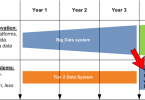“Customers chose BMC Helix because it enabled them to quickly and effectively modernize their ITSM operations, facilitating operational efficiency savings, enhanced user experience and productivity, and business agility for future needs”
Forrester recently conducted a study to measure the potential cost savings, business benefits and overall Total Economic Impact (TEI) that BMC Helix can have when deployed as the organization’s service management solution. In the study, Forrester examines the benefits BMC Helix gives organizations as they migrate from on-premise/hybrid to SaaS ITSM. Furthermore, it details various ROI and KPI measurements organizations gain from utilizing cognitive capabilities throughout their service management processes and environments. Forrester interviewed organizations on the quantified, qualified and flexibility benefits that BMC Helix ITSM, BMC Helix Digital Workplace and BMC Helix Chatbot had in transforming their enterprise.
Migration to SaaS
“Many SaaS products deliver higher benefits faster than on-premises ones because they are easier to use and configure. They also enable businesses to be more agile — for instance, allowing them to introduce new business models.”
Prior Forrester surveys have identified that cloud migration is a key enterprise strategy and hybrid- or multi-cloud deployments are now found in most organizations. Furthermore, these studies have shown that SaaS enables business agility and “delivers higher benefits faster” than on-premise solutions. Forrester’s industry research also indicates containerization are helping organizations to optimize their migration and service deployments.
In the Forrester BMC Helix TEI study, interviewed organizations in the study indicated that prior to deploying BMC Helix, they used a variety of ITSM solutions from various providers as well as deployments: on-premise, hybrid and cloud. They indicated some key drivers that triggered their transformation:
- Cost efficient, scalable solutions to meet/match business growth
- Centralized service management system: prioritize and routing requests
- Modern, mobile-friendly solution for end-users and agents to have choice in making/resolving requests
- Easily extensible for newest capabilities and future technologies (i.e. Artificial Intelligence)
Cognitive Service Management
“Automation is no longer optional for excellent customer experience — it’s mandatory.”
Forrester found that organizations want to not only improve agent efficiency both in terms of ticket resolution but also being able to scale and maximizing resources. The study also indicated along with this improvement and streamlining services, organizations are focusing on delivering compelling user experiences. This helps organizations make their service management capabilities more agile, faster and accurate.
BMC Helix: Impact to the Enterprise
Organizations that migrated to BMC Helix ITSM realized 354% ROI benefits over a three-year period and resulted in a $11.0M Present Value of Benefits.
The study showed how a composite organization can realize key benefits and results to add up to a Net Present Value of $8.6M (in a three-year period). These include:
- 45% improved service desk efficiency – saving $4.1M with cognitive service management
- Improved end-user productivity and customer satisfaction
- Up to 20% improved service agent efficiency
- Less than 6 months payback
Customer Comments:
“It’s a more efficient procedure to resolve the tickets [with BMC Helix ITSM]. We can push more information on how to auto-solve their request. There are portals to manuals for when they don’t know or remember how to access it, that helps us to solve more tickets automatically.”
Director of Service Management, Insurance
“With the BMC Helix Chatbot built on IBM Watson, BMC offered one platform that could be used across the entire shared services team. The additional capabilities that BMC Helix brings with every release has made it a good choice.”
VP of enterprise applications, professional services
“Return on investment [for implementing BMC Helix ITSM] was based on efficiency, time, and the ability to grow related to scale. Can it help us resign some existing customers for an additional three or five years? That is the kind of things we’re looking at.”







